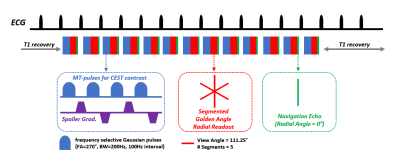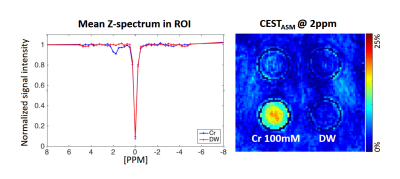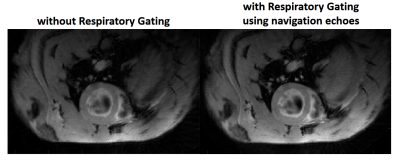2917
Golden Angle Radial Chemical Exchange Saturation Transfer for the Rat HeartPan ki Kim1, Chul Hwan Park2, Yoo Jin Hong1, and Byoung Wook Choi1
1Department of Radiology and Research Institute of Radiological Science, Severance Hospital, Yonsei University Medical Center, Seoul, Republic of Korea, 2Department of Radiology and Research Institute of Radiological Science, Gangnam Severance Hospital, Yonsei University Medical Center, Seoul, Republic of Korea
Synopsis
Chemical Exchange Saturation Transfer (CEST) has been attracting attention as a molecular imaging method to investigate myocardial muscle energetics according to creatine changes. In this study, we proposed a robust CEST imaging technique from cardiac and respiratory motion using golden angle radial readout to achieve CEST imaging at the heart of the rat. We investigated the feasibility of the proposed method for the creatine phantom and a normal rat.
INTRODUCTION
Chemical Exchange
Saturation Transfer (CEST) has been attracting attention as a molecular imaging
method to investigate myocardial muscle energetics according to creatine
changes. In this study, we proposed a robust CEST imaging technique from cardiac and respiratory motion
using golden angle radial readout to achieve CEST imaging at the heart of the
rat. We investigated the feasibility of the proposed method for the creatine
phantom and a normal rat.METHODS
As shown in Figure 1, motion-robust radial readout was used to apply CEST images to the heart of small animals. And golden angle radial trajectory was used to enable self-gating to remove the influence of breathing motion from the navigation echo. The train of magnetization transfer (MT) pulses were used for the CEST effect, and the MT pulse using the gaussian pulse had the properties of 270deg flip angle and 200Hz bandwidth. A segmented radial scan was performed in the mid-diastolic phase with CEST pulse for 10 seconds over 50 heart beats to give a sufficient CEST effect. Thereafter, it had a quiescent time of 5 seconds for T1 recovery. To investigate the feasibility of the radial CEST, we experimented with Creatine Phantom and normal Rat. Analysis of CEST was performed at 2 ppm using multiple Lorentzian fittings.2RESULTS
Figure 2 shows the result of the CEST experiment with Creatine phantom. The Cr sample with a concentration of 100 mM showed a high CEST contrast in the Z-spectrum and the CESTasym in the 2 ppm. Figure 3 shows the result of applying respiratory gating using the navigation echoes in a rat. Figure 4 shows the possibility of a radial CEST method in the heart of a normal rat. Weak CEST contrast was observed in the 2 ppm.DISCUSSION
We proposed a CEST imaging technique using a radial trajectory to obtain CEST images from the heart of a rat with rapid cardiac and respiratory cycles. As shown in the phantom experiment in Figure 2, the samples with creatine at 2 ppm showed a high CEST contrast but no distilled water (DW). In Figure 4, CEST contrast was also seen at 2 ppm in the heart of the in vivo rat. The navigation echo obtained at the end of a segmented radial scan can be used as a source of respiratory gating because it can detect changes due to breathing. The radial scan itself is robust to the artifacts associated with movement, but the use of respiratory gating has shown that the boundary between the myocardium and the blood becomes clearer.Acknowledgements
This work was supported by the National Research Foundation of Korea (RF) grant funded by the Korea government (MISP) (No. 2016R1C1B1013837)References
- Haris, Mohammad, et al. "A technique for in vivo mapping of myocardial creatine kinase metabolism." Nature medicine 20.2 (2014): 209-214.
- http://www.cest-sources.org/doku.php?id=cest_eval
Figures

Pulse
sequence diagram for acquiring CEST image of rat heart. Golden angle radial
acquisition was applied for small animals with rapid heartbeat and respiration,
and navigation echo could be applied to suppress respiratory movement. The
magnetization transfer (MT) pulse was used to give a CEST effect. Each RF pulse
was a gaussian pulse with a flip angle = 270degree, bandwidth = 200Hz. The MT
pulses are played from immediately after the ECG trigger to the mid-diastolic
phase. After that, radial scan and navigation echo are measured.

Radial
CEST was applied to phantoms with a creatinine concentration of 100 mM. The
signal drop was observed at 2 ppm of the z-spectrum of the creatine sample.

The
results of applying respiratory gating using the navigation echoes of the
proposed radial CEST. When self-gating is applied, there is a clear boundary
between myocardium and blood signal. However, even if respiratory gating is not
applied, artifacts related to breathing motion are not noticeable.

The
proposed radial CEST was applied to the heart and showed CEST effect in the
2ppm.